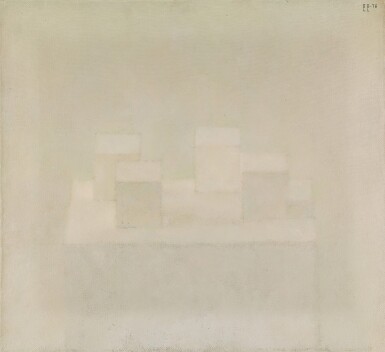Escape Artists – The Non-Conformists Online
Escape Artists – The Non-Conformists Online
Property from a Private Collection, France
VLADIMIR WEISBERG | FOUR CUBES
Lot Closed
October 1, 01:24 PM GMT
Estimate
20,000 - 30,000 GBP
Lot Details
Description
Property from a Private Collection, France
VLADIMIR WEISBERG
1924-1985
FOUR CUBES
signed with initials in Cyrillic and dated 76 t.r.; further inscribed with the artist's notes on the stretcher
oil on canvas
Canvas: 52 by 57cm, 20½ by 22½in.
Framed: 54.5 by 59.5cm, 21½ by 23½in.
To view Shipping Calculator, please click here
Collection of Elfrida Filippi, Paris
Thence by descent
V.G. Weisberg. Zhivopis', akvarel', risunok, Moscow: Gendalf, 1994, p.129, no.502 listed
Exhibition catalogue Vladimir Weisberg: collection particulière Elfrida Filippi, Moscow, 1997, p.25, no.502 illustrated
Moscow, Angelicos Gallery, Vladimir Weisberg: collection particulière Elfrida Filippi, June-August 1997, no.502
The present work comes from the collection of the French diplomat and collector Elfrida Filippi. Born in in the mountains of Corsica, Filippi first came to Moscow in 1974 where she was appointed cultural attaché by the French Embassy in Moscow. ‘Beautiful, elegant, charming when she likes you, icy-cold when she doesn’t (…) Her quick determination, readiness to face all fears, reluctance to let anyone down, keen interest in Russia… She carried herself well in dangerous situations, disarming all with her smile and grace’ – recalled the famous Russian dissident and intellectual Natalia Stolyarova. It was during Filippi’s first visit to Moscow that she befriended Vladimir Weisberg and fell in love with his work. ‘In a post-Khrushchev era when officials were still fighting “abstraction and formalism”, when no museum would exhibit, let alone buy his work, she quietly began her own collection.’ (quoted in Wladimir Weisberg: collection particulière Elfrida Filippi, Moscow 1997). Over the course of her diplomatic career in Russia, Elfrida Filippi amassed the greatest private collection of Weisberg’s work.
Four Cubes is a beautiful example of Weisberg’s so-called ‘white on white’ style, the purist aesthetic of form and shade which the artist developed in the 1960s. Influenced to a degree by European post-war abstraction, Weisberg sought to express the harmony of the world through his painting. 'If we had perfect eyesight, we would not be able to tell objects apart. We would see nothing but pure harmony' (the artist quoted in K.Muratova, Vladimir Veisberg. Dvadtsat’ vyskazyvanii, 2000).




